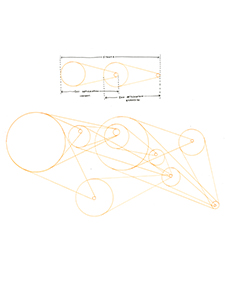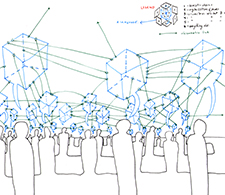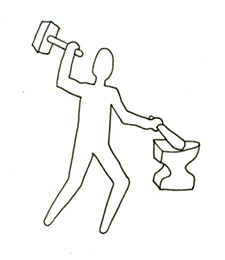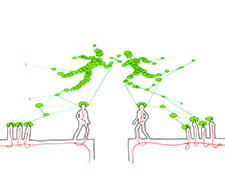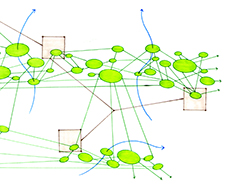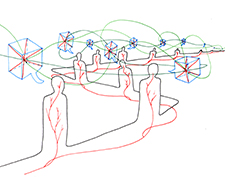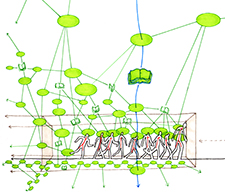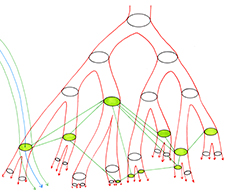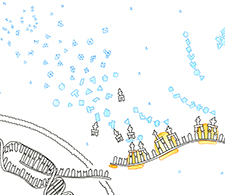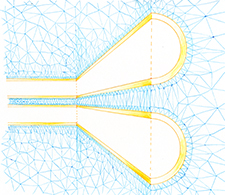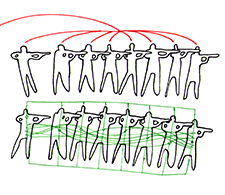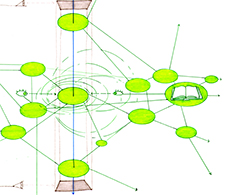Networks have structured our social – and media – development long before the emergence of the “network society.” From the letter-writing networks of the proto-Italian aristocracy to the electrical networks that facilitated industrialization; from the spread of woodcuts, pamphlets, and ballads that supported the Protestant Reformation to the twentieth century emergence of broadcast radio and television networks, media have always been situated in the matrices of networks of circulation and distribution, facilitating historically specific modes of connection. These histories often remain disconnected from research on digital networks, the latest to re-shape our socio-technical environment into a mesh of interconnecting nodes. An archaeological approach, one that routes between contemporary and historical networks, Alan Liu argues, has the potential to regenerate a sense of history that would temper the presentism of digital culture, all too often experienced as instantaneous and simultaneous.
This special issue of Amodern features original research, initially presented in 2012 at the “Network Archaeology” conference at Miami University of Ohio, on the histories of networks, the discrete connections that they articulate, and the circulatory forms of data, information, and socio-cultural resources that they enable. Drawing from the field of media archaeology, we conceptualize network archaeology as a call to investigate networks past and present – using current networks to catalyze new directions for historical inquiry and drawing upon historical cases to inform our understanding of today’s networked culture. In this introduction, we elaborate how network archaeology opens up promising areas for critical investigation, new objects of study, and prospective sites for collaboration within the productively discordant approach of media archaeology.
An Interview with Jussi Parikka
Jussi Parikka is a new media theorist and one of the preeminent scholars currently developing the innovative field of media archaeology. His recent books include an edited volume of Wolfgang Ernst’s writings entitled Digital Memory and the Archive (2013), What is Media Archaeology? (2012), Media Archaeology: Approaches, Applications, and Implications (2011, edited with Erkki Huhtamo), Insect Media: An Archaeology of Animals and Technology (2010), and Digital Contagions: A Media Archaeology of Computer Viruses (2007). Within these books and his other prolific writings, Parrika constructs a menagerie of philosophical insights concerning key pillars of digital culture: networks, the archive, biotechnology, and the logics (and illogics) of technical media.
A Feature Interview with Alan Liu
Alan Liu is known as a humanities scholar, but he might best be described as also an engineer of the humanities. He founded Voice of the Shuttle (VoS), the original web-based humanities index and search engine, and is the author of Wordsworth: The Sense of History (Stanford, 1989), The Laws of Cool: Knowledge Work and the Culture of Information (Chicago, 2004), and Local Transcendence: Essays on Postmodern Historicism and the Database (Chicago, 2008). Through all these projects he has engineered a series of enabling hacks on humanities methodologies that have changed the way scholars understand humanities research.
Toward the Dissolution of Certain Vectoralist Relations
That this momentous shift in no less than the spacetime of linguistic culture should be radically skewed by terms of use should remind us that it is, fundamentally, motivated and driven by vectors of utility and greed. What appears to be a gateway to our language is, in truth, an enclosure, the outward sign of a non-reciprocal, hierarchical relation. The vectoralist providers of what we call services harvest freely from our searches but we users are explicitly denied any such reciprocal opportunity, even though our aim may be to imitate, assist or to prosthetically – aesthetically – enhance: to beautify the human user.
With the rise of the information economy has come an industry devoted to policing that economy. It is a hybrid enterprise, composed of both public institutions like the FBI and private companies marketing protective and detective services. Its announced purpose is the defense of intellectual property. But its scope extends far beyond that, overlapping with the security industry made so notorious by the Snowden affair. In fact, this industry has shaped many of the everyday practices defining our culture of information. This paper describes how the information defense industry grew to become a global network enterprise, and argues that it is vital for us to appreciate it in these terms.
Situating Certain Literary Transactions over Networked Services
What if I, a good human, write a program that acts like a bad robot for good reasons, for aesthetic, culturally critical reasons, or to recapture some of that superb big data lying on the other side of the mouth-threshold where the powerful indexes dwell? Well, if I do that, it’s pretty bad, and it’s against most terms of use. Big software deploys whatever robots it wishes – indexing our web pages or policing our access to its services – and will deem these robots “good” without need of justification or regulation. But any robot that you or I build and that interacts with these services is “bad” by default.
Network Archaeology of/as the Stack
The stack is a crucial structure in computer software: a method of organizing code in memory when a program invokes subroutines, a schema that many algorithms use for managing data, and a diagram for conceptualizing how components of complex software systems interact. This paper introduces the stack as an apparatus beyond just a technical concept, positioning it as a structure that effects modes of power and knowledge formation in the age of software. The stack complements network archaeology’s focus on excavating deeper layers of technical media, but also challenges the tendency to essentialize these layers by inducing a mode of analysis always readily able to see another still lower level.
An Archaeology of Form
This paper traces the list as a paradigmatic form of non-narrative inscription. The analysis uses tools from media archaeology to excavate layers in which the list is inscribed and encoded within larger networks and infrastructures – be they analog, digital, or imaginative. It isolates a constitutive tension at the heart of the form, first described by Eco (2009) regarding literary lists, between “everything included” and “etcetera,” and argues that by tracing this tension in the analog worlds of writing and representation we can learn much about the persistence of the list form in operational, digital milieu, wherein the very same processes and tensions are negotiated.
An archaeology of networks depends upon the painstaking recovery of fragments that have fortuitously survived, yet it equally profits from the staggering absences toward which those fragments direct the imagination. Hidden within today’s large technical systems for information flow are the traces of a different, more local order of communication.
Network Archaeology at Gaumont’s Cité Elgé
Although better known as one of the world’s largest early film studios, by the late 1910s, Gaumont’s Cité Elgé had become a key node in the networks of media development that linked cinema, military, and telecommunications technologies. Following the war, Gaumont made new media technologies central to its efforts to survive despite declining film profits. Focusing on the company’s non-film work, this article describes an alternative history of Gaumont as an intermedial producer of technology and visual art. It argues that we should look back to the Cité Elgé with an eye to the important ways that studios have long contributed to the kind of intermedial relationships that have conditioned today’s “convergent” new media landscape.
Signaling (Racial) Excess from the Historic Movie Palace-Turned-Church
While American movie palaces have historically been associated with white middle-class film audiences, in their post-cinematic uses they have acted as significant nodes in alternative media networks catering to racially diverse constituents. The conversion of one such palace in Washington Heights shows how cinematic infrastructures have provided a symbolic and material foundation for the convergence of Black televangelism and American megachurches. This article suggests scholarly methods for pushing beyond nostalgic invocations of traditional film culture in order to address the vibrant social networks and media cultures that emerge in repurposed movie theaters.
Listening to Historic Urban Infrastructures
What might media archaeologists of the Kittlerian variety have to learn from archaeologists of the Indiana Jones school? In studying the networked urban environment, there’s much to be gained by taking up trowels and examining the material artifacts of urban communication. This is particularly true in exploring the history of the “sonic city” – the city of radio waves and public address and everyday conversation. The material spaces in which echoes once reverberated can offer invaluable clues about how our cities (re-)sound. We find that our media histories are deeply networked with our urban and architectural histories, and that, in many cases, these cultural and technological forms are mutually constructed.
In the early 1930s, a new National Grid brought electricity to the length and breadth of Great Britain. A new network, visible in the form of pylons and high-tension cables, transformed the countryside into a new location of modernity, refashioning landscape into wirescape and enabling new modes of aesthetic response to connectivity. This article approaches the high-voltage grid by way of three very different works of the 1930s: the “Pylon” poems of Stephen Spender and Stanley Snaith, Paul Rotha’s documentary The Face of Britain, and Alfred Hitchcock’s Sabotage. Connecting these disparate sources, it shows how a specific form of network-mindedness emerged at a key moment of technological, political, and cultural transition.
Approaching the fluidity and ephemerality of urban transport through an exploration of its material media culture, this article considers the influence of the London Tube Map design in the 1920s and 30s, along with elements of a material network archaeology. In drawing on the historical networking practices of London Transport, the article places emphasis on the uniqueness and situated character of networks, as opposed to generalizing theories like social network analysis and complex networks science. The humanities approach to material socio-technical networks takes their tacit local operations, the formation of synchronized network time, and the specific relationship between perception and circulation into account.
Railroads and Photographs
Today we tend to visualize networks through metaphors and aesthetics offered by digital media. In the Post-Civil War United States, however, different ideas of spatiotemporal connection emerged in relationship with the new medium of photography and the construction of transcontinental railroads. Nineteenth-century sets of railroad photographs, which follow train lines through ordered sequences of images, coordinated multiple aspects into the conceit of a continuous view. A “network archeology” of railroad photographs discloses how specific contexts and implications attend any, of many, ways we might imagine and picture connection.
On the Ethereal Origins of Local Area Networks
The language used to describe local area networks (LANs) in the 1970s reflect 19th century notions of the transcendental promise of technology as a means to bridge time and space thereby eliminating physical impediments to communication. At the same time, however, architects of early LAN systems were deeply engaged with technical problems that resulted from building larger networks that moved data in a shorter amount of time. The paper looks to the discursive ethereal origins of early computer networks to trouble teleological narratives regarding the progressive dematerialization of communication infrastructure.
An Archaeological Approach to Locative Media
When connected to a network, locative media encompass a range of technological, bodily, spatial, and cultural components that are not completely unique to contemporary technologies. This paper suggests that the marginalized history of divining rods can be linked to a historical constellation of which locative media are the latest manifestation. This archaeological approach takes into account forgotten continuities with the divining rod, which as an orientation device, is often disarticulated from contemporary network technologies. The result is a focus on the desire to reveal extra dimensions of space or the networked externalization of consciousness – a desire that some see realized via the mediation of the digital network.
Closed-World and Green-World Networks in the Work of John C. Lilly
In the 1950s and 1960s, renowned neurophysiologist, John C. Lilly, received a series of grants from several U.S. government agencies including the Navy to conduct experimental research on the communication between humans and dolphins. This article traces the shift from Lilly neuroelectric networks, built at the National Institute of Mental Health in the 1950s, to bioacoustic and biochemical networks developed at his Communication Research Institute in the 1960s. This shift points to a much greater diversity of network materials, practices and configurations than is commonly thought to have existed in the postwar period.
The Guerilla Video Tape Network
In the late 1960s, guerrilla television emerged as an alternative to corporate TV. This essay argues that television broadcasts of guerrilla video were merely the “aboveground” operations of an underground network built on half-inch videotape and the US Postal Service. The “guerrilla” aspects of guerrilla television are found in its use of distributed exchange networks, not in the occasional disruptive appearance of countercultural content and experimental aesthetics in the flow of conventional television. This essay aims to shift the discussion of guerrilla television away from the politics of aesthetics and content, to consider the politics of production and distribution, and the radical power of physical media in the digital age.
From Paper to Microfilm to Database
This paper seeks to better understand what happens to the newspaper when its print and microfilm forms are digitized and databased. This transfigurative process creates a complex weave of materials, practices and protocols circulating from public institutions to a series of private corporations, and, as the digitized papers flicker in and out of visibility, raises important questions about access. The result is the epitome of what Roy Rosenzweig has described as “the fragility of evidence in the digital era,” and a natural object for investigation through network archaeology.
High-quality scanners, cheap storage media, open file formats, peer-to-peer networking and high-bandwidth home connections have all contributed to the unauthorized online availability of magazines and comic books. But what is a scholar to do when confronted with such objects? Is a set of digital comic book scans an “archive” in the traditional sense? How do we study the circulatory practices of comic book scanners when traces of their activities barely exist? And what are the ethics of studying objects that would not exist without copyright infringement, yet are unavailable in most libraries? This paper presents the initial findings of an ongoing research project into the production, circulation and consumption of unauthorized digital comic book scans.




